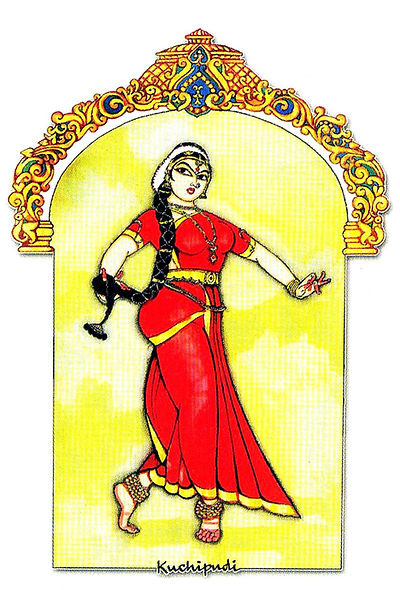.png)
Kuchipudi

Kuchipudi is a classical dance form from the southeastern state of Andhra Pradesh in India, known for its graceful movements, expressive storytelling, and a unique blend of dance, drama, and music. Unlike many other classical Indian dances, Kuchipudi did not originate as a temple ritual or form of worship. Instead, it began as a tradition of traveling dance-dramas, known as "Yakshaganas," where troupes of performers, typically male Brahmins, would travel from village to village, staging performances based on stories from the Puranas. In addition to these sacred narratives, Kuchipudi performances often addressed contemporary social issues, using dance as a medium to bring relevant concerns to light. This made Kuchipudi not only a source of entertainment but also a powerful tool for social commentary in ancient times.
Siddhendra Yogi, a revered saint and visionary, is considered the pioneer of the Kuchipudi dance tradition. Born in the 17th century in the village of Kuchipudi, Andhra Pradesh, he played a crucial role in shaping the art form and giving it a distinctive identity. Siddhendra Yogi was not only a spiritual leader but also an accomplished dancer and choreographer. He is credited with the establishment of the Yakshagana tradition in Kuchipudi, where he infused dance with deep spiritual meaning, drawing inspiration from the Puranas. Through his teachings and compositions, he laid the foundation for what would become the classical dance form we know today as Kuchipudi, emphasizing the importance of storytelling and devotional themes in dance. His influence continues to resonate in the performances of Kuchipudi dancers, who honor his legacy through the art form's intricate movements and expressive storytelling.
Over time, this itinerant tradition transformed, evolving into one of India's most cherished classical dance forms. As the art form gained recognition, it embraced both male and female performers, expanding its appeal and moving beyond its original format of group performances to include solo presentations. While Kuchipudi retains elements of its early dramatic roots, it has become renowned for its rich combination of fluid dance movements, dramatic expression, and intricate footwork, making it one of the most visually compelling and emotionally resonant classical dance styles.
What sets Kuchipudi apart from other classical Indian dances is its distinctive use of Natya (drama), blending both dance and dramatic expression. Performers are not only skilled dancers but also accomplished actors, bringing characters to life with vivid facial expressions, intricate hand gestures (mudras), and nuanced body language. When Sahityam (spoken or sung text) is present in the narrative, dancers employ Vachika Abhinaya—spoken or recited dialogue—to further enhance the storytelling. This element of speech, when integrated with movement, deepens the emotional impact of the performance. Each Kuchipudi performance is accompanied by a live orchestra, with the vocalist narrating the story through traditional Carnatic music, and the dancers interpreting the lyrics with precise footwork and graceful gestures.
Kuchipudi is characterized by a unique balance between rhythm and grace. The dancers often begin with invocations to the gods, followed by pure dance sequences that showcase complex footwork, swift turns, and elegant body postures. The storytelling aspect comes into play in the abhinaya (expressive) sections, where the dancer enacts stories, typically based on the Puranas, with the help of emotive facial expressions, carefully choreographed gestures, and, when necessary, Vachika Abhinaya. One of the hallmark performances in Kuchipudi is the Tarangam, where dancers balance on the rim of a brass plate while executing complex footwork to the rhythm of classical music, a feat that requires immense precision and control.
A pivotal figure in the modern history of Kuchipudi is the legendary Vempati Chinna Satyam, who played a transformative role in bringing the art form to a global audience. Born in 1929 in Kuchipudi village, Vempati Chinna Satyam is celebrated for codifying and formalizing the techniques of Kuchipudi, elevating it from a regional art form to one that is recognized on the international stage. His efforts to systematize the teaching of Kuchipudi, along with his innovative choreography, enabled the dance form to transcend its traditional boundaries and become accessible to all, including women. He also introduced new themes, movements, and technical refinements while maintaining the core essence of Kuchipudi, ensuring that the art form continued to evolve without losing its traditional roots. Under his tutelage, Kuchipudi blossomed into a solo performance style that dazzled audiences around the world.
In modern times, Kuchipudi has transcended cultural and geographical boundaries, gaining international recognition for its beauty and depth. Renowned artists and teachers have played a pivotal role in popularizing the art form globally, performing at prestigious festivals, cultural events, and stages around the world. Through workshops, performances, and collaborations, Kuchipudi has reached new audiences while preserving its ancient traditions.
Today, Kuchipudi is not just a dance form but a means of connecting with India's rich cultural heritage. It continues to inspire new generations of artists, preserving its classical essence while adapting to contemporary narratives. Whether performed on the grand stages of international festivals or in the more intimate settings of temple courtyards, Kuchipudi remains a mesmerizing art form that captivates and moves audiences with its eloquent storytelling, Vachika Abhinaya, and timeless beauty.